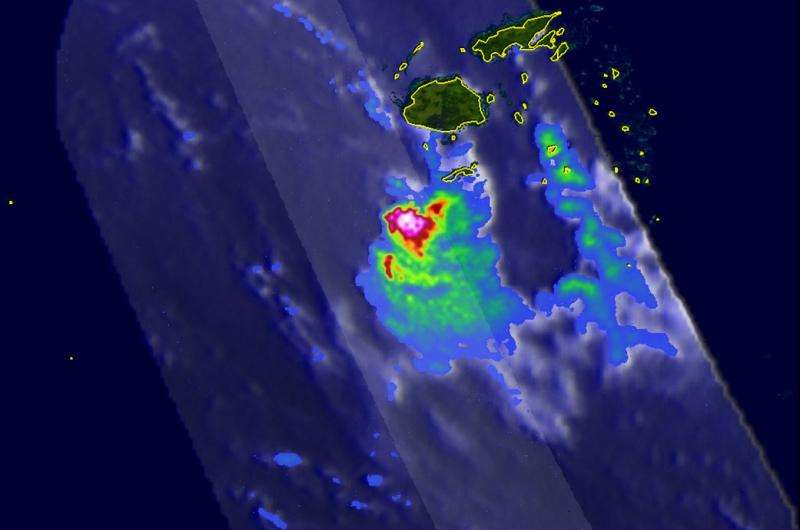NASA finds very heavy rainfall in Tropical Cyclone Zena

Tropical cyclone Zena intensified over the open waters between Vanuatu and Fiji and the Global Precipitation Measurement mission core satellite known as GPM found very heavy rainfall and very high cloud tops. By the next day, April 7, Zena was on its way to dissipation.
At peak intensity Zena had sustained winds estimated at about 90 knots (104 mph). The GPM core observatory satellite had an excellent view of tropical cyclone Zena on April 6, 2016 at 0933 UTC (4:33 a.m. EDT) when tropical cyclone Zena was located southwest of Fiji.
Zena had started to weaken but still had maximum sustained wind speeds estimated at 80 knots (92 mph/148.2 kph). An analysis of GPM's Microwave Imager (GMI) and Dual-Frequency Precipitation Radar (DPR) data revealed the intensity of some very heavy showers in the tropical cyclone. The most intense rainfall was measured by GPM's radar (DPR) falling the amazing rate of almost 300 mm (11.8 inches) per hour.
At NASA's Goddard Space Flight Center in Greenbelt, Maryland a 3-D image of the data was created to help show cloud heights. The higher the clouds, the stronger a storm can be. The 3-D cross-section was created using radar intensity data from the GPM satellite. It showed that some storm tops in these intense thunderstorms were reaching altitudes above 17 km (10.5 miles). GPM is a joint missions between NASA and the Japanese space agency JAXA.
Just one day later, on April 7, Zena moved into an area with strong vertical wind shear that was tearing the structure of the storm apart causing it to weaken quickly.
By 0900 UTC (4 a.m. EDT) the Joint Typhoon Warning Center (JTWC) issued their final warning on the tropical cyclone. At that time, maximum sustained winds had dropped significantly to 35 knots (40 mph/62 kph). It was centered near 22.1 degrees south latitude and 173.4 degrees west longitude, about 108 nautical miles (124 miles/200 km) east-southeast of Tonga. Zena was moving to the east-southeast at 25 knots (28.7 mph/46.3 kph).
Tropical Cyclone Zena is already dissipating under hostile atmospheric conditions while moving away from Tonga.
Provided by NASA's Goddard Space Flight Center




















